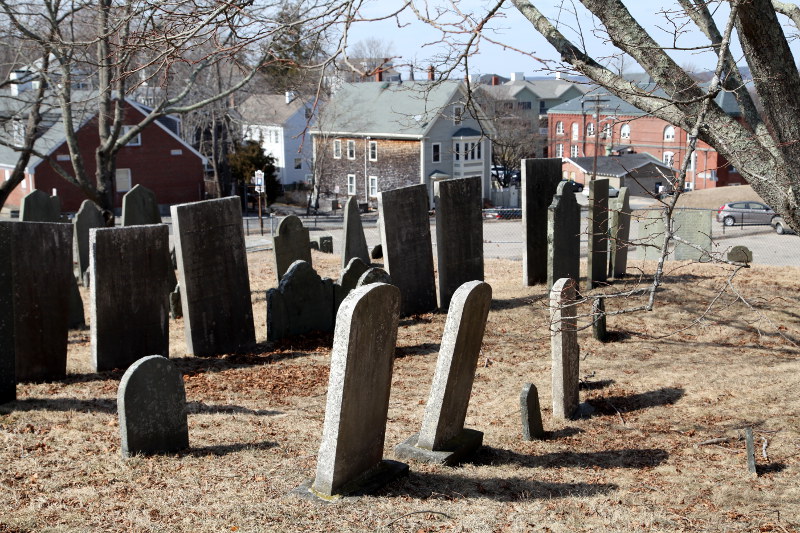O spot in Plymouth is so interesting to the antiquary as Burial Hill. Here are the sites of the Pilgrim’s fort and watchtower. Here sleep the early settlers of the colony, the heroes of the Revolution and of our later wars, and the men who went “down to the sea in ships” and braved dangers, in the days of Plymouth’s maritime glory. — HANDBOOK OF PLYMOUTH, MASSACHUSETTS, 1902.
One of the first tenets in the study of history and that history lies. The historical record is written by literate people who often have their own interpretations, prejudice, or political agenda when writing; as such, everything else disappears with the sands of time.
History is also frequently rewritten as a means of propaganda and in more recent times, embellished to increase tourist activity in a city or town. This makes it difficult to separate out what is true and what is being told as a means of guiding people to the desired outcome (e.g. spending money).
However, in years of travel and historical study, the one thing I have learned is that graveyards don’t lie; and the Burial Hill Cemetery in Plymouth tells all kinds of stories about the town.
Headstones exist in the cemetery for the early Pilgrims, but most of these came hundreds of years after their deaths. Some are huge monuments and cenotaphs that were clearly made in a different era. William Bradford’s memorial (photo #16) is an example of this. Bradford (1590-1657) was a signatory to the Mayflower Compact who served as the governor of the colony for 30-years. When he died in 1657, he would have likely had a simple headstone with few words (as was the early Puritan tradition).
Thomas Cushman’s granite monument is another example (#21). The original 1691 stone was moved in 1858 and replaced by the existing monument. Cushman came to New England on the Fortune in November 1621 with his father who came to the colony on London Adventurers business. Strangely (to me), even though he was a young boy, his father left Thomas with the Colonists when he returned to England. The boy stayed and eventually became the church’s Ruling Elder. As a Puritan, I doubt he would have wanted an elaborate and expensive granite monument over his grave.
These two examples are notable and successful colonists who were respected in the community. These were the writers of history and leaders in the town; as such, Plymouth has chosen to draw attention to them in death. There are, however, other burials in the town that are not on display.
One of the historians that we met during our visit mentioned that in local folklore, most of the Pilgrims who arrived in Plymouth and died during the first winter were buried in a mass grave on Coles Hill. No markers were left and no proof of these burials was ever recorded. Outside of hearsay, no one actually knows the final resting place of these first Pilgrims.
However, during a flood in 1735, bones were washed out of Coles Hill and it has long been assumed that these are Pilgrim bones (and not Indigenous Americans like some have suggested). What’s interesting to me about this is that these bones have sat untouched for hundreds of years in a crypt on the hill. It would be easy for an osteologist to look at the bones (assuming they are all there) and tell whether they are Indigenous American or European. This would put to rest any speculation about their origin.
Then there’s Squanto, a Patuxet guide and interpreter, who is reputed to be responsible for the survival of the Pilgrims after their first winter in the New World. He was a skilled negotiator who managed to keep the peace between the Wampanoag and Pilgrims for decades (even after being kidnapped by the English/Spanish on different occasions). When he died it was of suspected poisoning and no one knows where he is buried. It is assumed that he is in an unmarked grave somewhere in Burial Hill.
The oldest surviving headstone in the graveyard is that of Edward Gray (#9), a wealthy merchant who arrived in the colony in 1643 and married the daughter of John and Mary (Chilton) Winslow; Mary was a passenger on the Mayflower and John one of the men who arrived on the Fortune. Gray has a simple slate gravestone (1681), which was a common material used in the Boston area; however, there are none of the typical New England carvings on the headstone (as seen on others that come from a year later).
Other early original graves that show typical New England carvings:
- William Crowe (#8 but missing original grave in the photo) (1683)
- Hannah Clark (#20) (1687)
- Thomas Clark (#10, #11) (1697)
